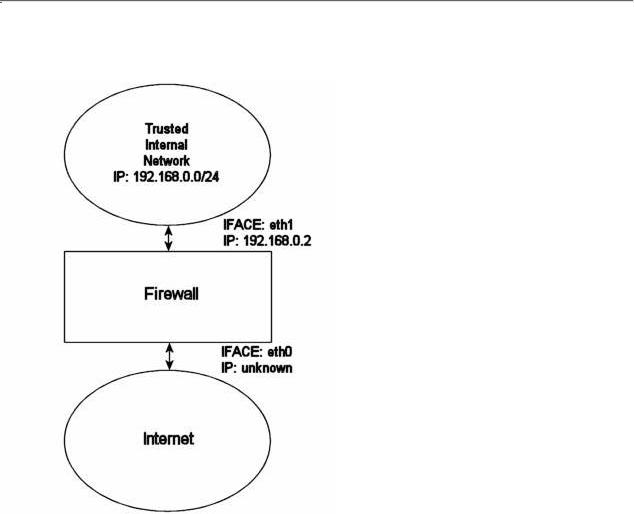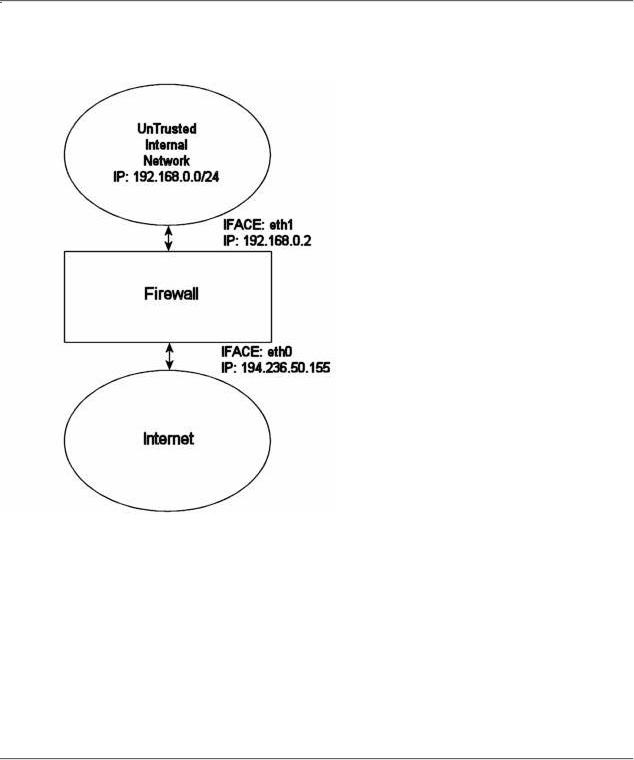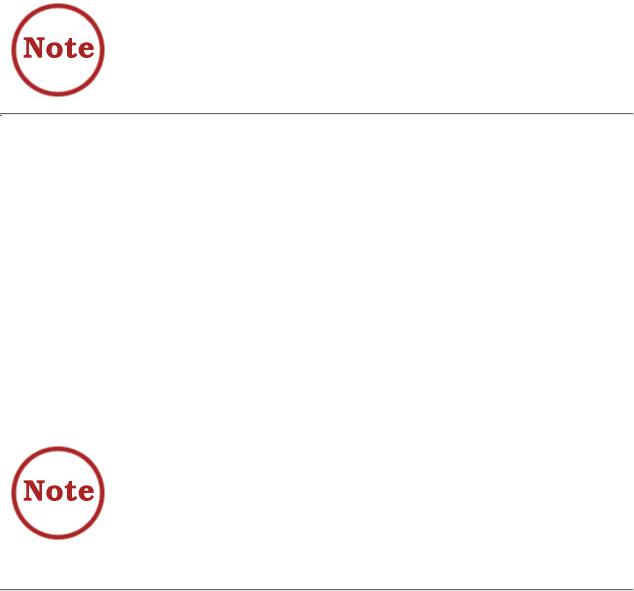
Andreasson O.Iptables tutorial V1.1.9.2001
.pdf
Iptables Tutorial 1.1.9 |
Página 191 |
$IPTABLES -t nat -A PREROUTING -p TCP -i $INET_IFACE -d $DNS_IP --dport 53 -j DNAT --to-destination $DMZ_DNS_IP
First of all, DNAT can only be performed in the PREROUTING chain of the nat table. Then we look for TCP protocol on our $INET_IFACE with destination IP that matches our $DNS_IP, and is directed to port 53, which is the TCP port for zone transfers between DNS's. If we actually get such a packet we give a target of DNAT, in other words Destination NAT. After that we specify where we want the packet to go with the --to-destination option and give it the value of $DMZ_DNS_IP, in other words the IP of the DNS on our DMZ network. This is how basic DNAT works. When the reply to the DNAT'ed packet is sent through the firewall, it automatically gets un-DNAT'ed.
By now you should have enough understanding of how everything works to be able to understand this script pretty well without any huge complications. If there is something you don't understand, that hasn't been gone through in the rest of the tutorial, mail me since it is probably a fault on my side.
rc.DHCP.firewall.txt
The rc.DHCP.firewall.txt script is pretty much identical to the original rc.firewall.txt. However, this script no longer uses the STATIC_IP variable, which is the main change to the original rc.firewall.txt script. The reason is that this won't work together with a dynamic IP connection. The actual changes needed to be done to the original script is minimal, however, I've had some people mail me and ask about the problem so this script will be a good solution for you. This script will allow people who uses DHCP, PPP and SLIP connections to connect to the internet.
http://people.unix-fu.org/andreasson/iptables-tutorial/iptables-tutorial.html |
21:25:51 10/06/2002 |

Iptables Tutorial 1.1.9 |
Página 192 |
The main changes done to the script consists of erasing the STATIC_IP variable as I already said and deleting all referenses to this variable. Instead of using this variable the script now does it's main filtering on the variable INET_IFACE. In other words -d $STATIC_IP has been changed to -i $INET_IFACE. This is pretty much the only changes made and that's all that's needed really.
There is some more things to think about though. We can no longer filter in the INPUT chain depending on, for example, --in-interface $LAN_IFACE --dst $INET_IP. This in turn forces us to filter only based on interfaces in such cases where the internal machines must access the internet adressable IP. One great example is if we are running an HTTP on our firewall. If we go to the main page, which contains static links back to the same host, which could be some dyndns solution, we would get a real hard trouble. The NAT'ed box would ask the DNS for the IP of the HTTP server, then try to access that IP. In case we filter based on interface and IP, the NAT'ed box would be unable to get to the HTTP because the INPUT chain would DROP the packets flat to the ground. This also applies in a sense to the case where we got a static IP, but in such cases it could be gotten around by adding rules which checks the LAN interface packets for our INET_IP, and if so ACCEPT them.
As you may read from above, it may be a good idea to grab a script, or write one, that handles dynamic IP in a better sense. We could for example make a script that grabs the IP from ifconfig and adds it to a variable, upon bootup of the internet connection. A good way to do this, would e to use for example the ip-up scripts provided with pppd and some other programs. For a good site, check out the linuxguruz.org iptables site which has a huge collection of scripts available to download. You will find a link to the linuxguruz.org site from the Other resources and links appendix.
This script might be a bit less secure than the rc.firewall.txt script. I would definitely advise you to use that script if at all possible since this script is more open to attacks from the outside.
Also, there is the possibility to add something like this to your scripts:
INET_IP=`ifconfig $INET_IFACE | grep inet | cut -d : -f 2 | cut -d \ -f 1`
The above would automatically grab the IP address of the $INET_IFACE variable, grep the correct line which contains the IP address and then cuts it down to a manageable IP address. However, there are serious drawbacks with this approach, as described in the following list.
1.If the script is run from within a script which in turn is executed by, for example, the PPP daemon, it will hang all currently active connections due to the NEW not SYN rules (see the State NEW packets but no SYN bit set section). It is possible to get by, if you get rid of the NEW not SYN rules for example, but it is questionable.
2.If you got rules that are static and always want to be around, it is rather harsh to add and erase rules all the time, without hurting the already existing ones. For example, if you want to block hosts on your LAN to connect to the firewall, but at the same time operate a script from the PPP daemon, how would you do it without erasing your already active rules blocking the LAN?
http://people.unix-fu.org/andreasson/iptables-tutorial/iptables-tutorial.html |
21:25:51 10/06/2002 |

Iptables Tutorial 1.1.9 |
Página 193 |
3.It may get unnecessarily complicated, as seen above which in turn could lead to security compromises. If the script is kept simple, it is easier to spot problems, and to keep order in it.
rc.UTIN.firewall.txt
The rc.UTIN.firewall.txt script will in contrast to the other scripts block the LAN that is sitting behind us. In other words, we don't trust anyone on any networks we are connected to. We also disallow people on our LAN to do anything but specific tasks on the Internet. The only things we actually allow is POP3, HTTP and FTP access to the internet. We also don't trust the internal users to access the firewall more than we trust users on the Internet.
This script follows the golden rule to not trust anyone, not even our own employees. This is a sad fact, but a large part of the hacks and cracks that a company gets hit by is a matter of people from their own staff perpetrating the hit. This script will hopefully give you some clues as to what you can do with your firewall to strengthen it up. It's not very different from the original rc.firewall.txt script, but it does give a few hints at what we would normally let through etc.
rc.test-iptables.txt
http://people.unix-fu.org/andreasson/iptables-tutorial/iptables-tutorial.html |
21:25:51 10/06/2002 |

Iptables Tutorial 1.1.9 |
Página 194 |
The rc.test-iptables.txt script can be used to test all the different chains, but it might need some tweaking depending on your configuration, such as turning on ip_forwarding, and setting up masquerading etcetera. It will work for mostly everyone though who has all the basic set up and all the basic tables loaded into kernel. All it really does is set some LOG targets which will log ping reply's and ping requests. This way, you will get information on which chain was traversed and in which order. For example, run this script and then do:
ping -c 1 host.on.the.internet
And tail -n 0 -f /var/log/messages while doing the first command. This should show you all the different chains used and in which order, unless the log entries are swapped around for some reason.
This script was written for testing purposes only. In other words, it's not a good idea to have rules like this that logs everything of one sort since your log partitions might get filled up quickly and it would be an effective Denial of Service attack against you and might lead to real attacks on you that would be unlogged after the initial Denial of Service attack.
rc.flush-iptables.txt
The rc.flush-iptables.txt script should not really be called a script in itself. The rc.flush-iptables.txt script will reset and flush all your tables and chains. The script starts by setting the default policies to ACCEPT on the INPUT, OUTPUT and FORWARD chains of the filter table. After this we reset the default policies of the PREROUTING, POSTROUTING and OUTPUT chains of the nat table. We do this first so we won't have to bother about closed connections and packets not getting through. This script is intended for actually setting up and troubleshooting your firewall, and hence we only care about opening the whole thing up and reset it to default values.
After this we flush all chains first in the filter table and then in the NAT table. This way we know there is no redundant rules lying around anywhere. When all of this is done, we jump down to the next section where we erase all the user specified chains in the NAT and filter tables. When this step is done, we consider the script done. You may consider adding rules to flush your MANGLE table if you use it.
One final word on this issue. Certain people has mailed me asking from me to put this script into the original rc.firewall script using redhat Linux syntax where you type something like rc.firewall start and the script starts. However, I will not do that since this is a tutorial and should be used as a place to fetch ideas mainly and it shouldn't be filled up with shell scripts and strange syntax. Adding shell script syntax and other things makes the script harder to read as far as I am concerned and the tutorial was written with readability in mind and will continue being so.
Detailed explanations of special commands
http://people.unix-fu.org/andreasson/iptables-tutorial/iptables-tutorial.html |
21:25:51 10/06/2002 |

Iptables Tutorial 1.1.9 |
Página 195 |
Listing your active ruleset
To list your currently active ruleset you run a special option to the iptables command, which we have discussed briefly previously in the How a rule is built chapter. This would look like the following:
iptables -L
This command should list your currently active ruleset, and translate everything possible to a more readable form. For example, it will translate all the different ports according to the /etc/services file as well as DNS all the IP addresses to get DNS records instead. The later can be a bit of a problem though. For example, it will try to resolve LAN IP addresses, ie 192.168.1.1, to something useful. 192.168.0.0/16 is a private range though and should not resolve to anything and the command will seem to hang while resolving the IP. To get around this problem we would do something like the following:
iptables -L -n
Another thing that might be interesting is to see a few statistics about each policy, rule and chain. We could get this by adding the verbose flag. It would then look something like this:
iptables -L -n -v
There is also a few files that might be interesting to look at in the /proc filesystem. For example, it might be interesting to know what connections are currently in the conntrack table. This table contains all the different connections currently tracked and serves as a basic table so we always know what state a connection currently is in. This table can not be edited and even if it was possible, it would be a bad idea. To see the table you can run the following command:
cat /proc/net/conntrack | less
The above command will show all currently tracked connections even though it might be a bit hard to understand everything.
Updating and flushing your tables
If at some point you screw up your iptables, there are actually commands to flush them, so you don't have to reboot. I've actually gotten this question a couple times by now so I thought I'd answer it right here. If you added a rule in error, you might just change the -A parameter to -D in the line you added in error. iptables will find the erroneous line and erase it for you, in case you've got multiple lines looking exactly the same in the chain, it erases the first instance it finds matching your rule. If this is not the wanted behaviour you might try to use the -D option as iptables -D INPUT 10 which will erase the 10th rule in the INPUT chain.
There is also instances where you want to flush a whole chain, in this case you might want to run the -F option. For example, iptables -F INPUT will erase the whole INPUT chain, though, this will not change
http://people.unix-fu.org/andreasson/iptables-tutorial/iptables-tutorial.html |
21:25:51 10/06/2002 |

Iptables Tutorial 1.1.9 |
Página 196 |
the default policy, so if this is set to DROP you'll block the whole INPUT chain if used as above. To reset the chain policy, do as how you set it to DROP, for example iptables -P INPUT ACCEPT.
I have made a small script (available as an appendix as well) that will flush and reset your iptables that you might consider using while setting up your rc.firewall.txt file properly. One thing though, if you start mucking around in the mangle table, this script will not erase those, it is rather simple to add the few lines needed to erase those but I have not added those here since the mangle table is not used in my rc.firewall.txt script so far.
Common problems and questionmarks
Passive FTP but no DCC
This is one of the really nice parts about the new iptables support in the 2.4.x kernels, you can for example allow Passive FTP connections, but not allow DCC send functions with the new state matching code. You may ask yourself how, well, its quite simple once you get to think of it. Just compile the ip_conntrack_irc, ip_nat_irc, ip_conntrack_ftp and ip_nat_ftp code as modules and not statically into the kernel. What these modules do is that they add support to the connection tracking machine and the NAT machine so they can distinguish and modify a Passive FTP connection or a DCC send connection. Without these modules they can't recognize these kinds of connections.
If you for example want to allow Passive FTP, but not DCC send, you would load the ip_conntrack_ftp and ip_nat_ftp modules, but not the ip_conntrack_irc and ip_nat_irc modules and then do:
/usr/local/sbin/iptables -A INPUT -p TCP -m state --state RELATED -j ACCEPT
To allow Passive FTP but not DCC. If you would want to do the reverse, you'd just load the ip_conntrack_irc and ip_nat_irc modules, but not the ip_conntrack_ftp and ip_nat_ftp modules. Do note that the ip_nat_* modules are only needed in case you need and want to do Network Adress Translation on the connections, ie, if you want to let people run IRC from your local network which is using a NAT'ed or masqueraded connection to the internet.
For more information about Active and Passive FTP, read RFC 959 - File Transfer Protocol by J. Postel and J. Reynolds. This RFC contains information regarding the FTP protocol and Active and Passive FTP and how they work. As you can understand from this document, during Active FTP the client sends the server an IP address and random port to use and then the server connects to this port on the client. In case your client sits behind a Network Address Translationing system (iptables), then the packets data section needs to be NAT'ed too, that is what the ip_nat_ftp module does. In Passive FTP, the proceeding is reversed. The client tells the server that it wants to send or receive data and the server replies, telling the client what address to connect to and what port to use.
State NEW packets but no SYN bit set
http://people.unix-fu.org/andreasson/iptables-tutorial/iptables-tutorial.html |
21:25:51 10/06/2002 |

Iptables Tutorial 1.1.9 |
Página 197 |
There is a certain feature in iptables that is not so well documented and may therefore be overlooked by a lot of people(yes, including me). If you use state NEW, packets with the SYN bit unset will get through your firewall. This feature is there because in certain cases we want to consider that a packet may be part of an already ESTABLISHED connection on, for instance, another firewall. This feature makes it possible to have two or more firewalls, and for one of the firewalls to go down without any loss of data. The firewalling of the subnet could then be taken over by our secondary firewall.This does however lead to the fact that state NEW will allow pretty much any kind of TCP connection, regardless if this is the initial 3-way handshake or not. To take care of this problem we add the following rules to our firewalls INPUT, OUTPUT and FORWARD chain:
$IPTABLES -A INPUT -p tcp ! |
--syn -m state |
--state NEW -j LOG --log-prefix "New not |
syn:" |
|
|
$IPTABLES -A INPUT -p tcp ! |
--syn -m state |
--state NEW -j DROP |
The above rules will take care of this problem. This is a badly documented behaviour of the netfilter/iptables project and should definitely be more highlighted. In other words, a huge warning is in it's place for this kind of behaviour on your firewall.
Note that there is some troubles with the above rules and bad Microsoft TCP/IP implementations. The above rules will lead to certain conditions where packets generated by microsoft products gets labeled as a state NEW and hence get logged and dropped. It will however not lead to broken connections to my knowledge. The matter is that when a connection gets closed and the final FIN/ACK has been sent and the state machine of netfilter has closed this connection and it is no longer in the conntrack table. At this point the faulty Microsoft implementation sends another packet which is considered as state NEW but lacks the SYN bit and hence gets matched by the above rules. In other words, don't worry to much about this rule, or if you are worried anyways, set the --log-headers option to the rule and log the headers too and you'll get a better look at what the packet looks like.
There is one more known problem with these rules. If someone is currently connected to the firewall, lets say from the LAN, and you have the script set to be activated when running a PPP connection. In this case, when you start the PPP connection, the person previously connected through the LAN will be more or less killed. This only applies when you are running with the conntrack and nat codebases as modules, and the modules are loaded and unloaded each time you run the script. Another way to get this problem is to run the rc.firewall.txt script from a telnet connection from a host not on the actual firewall. To put it simple, you connect with telnet or some other stream connection. Start the connection tracking modules, then load the NEW not SYN packet rules. Finally, the telnet client or daemon tries to send something. the connection tracking code will not recognise this connection as a legal connection since it has not seen packets in any direction on this connection before, also there will be no SYN bits set since it is not actually the first packet in the connection. Hence, the packet will match to the rules and be logged and afterwards dropped to the ground.
Internet Service Providers who use assigned
http://people.unix-fu.org/andreasson/iptables-tutorial/iptables-tutorial.html |
21:25:51 10/06/2002 |

Iptables Tutorial 1.1.9 |
Página 198 |
IP addresses
I have added this since a friend of mine told me something I have totally forgotten. Certain stupid Internet Service Providers use IP addresses assigned by IANA for their local networks on which you connect to. For example, the swedish Internet Service Provider and phone monopoly Telia uses this approach for example on their DNS servers, which uses the 10.x.x.x IP address range. The problem you will most probably run into is that we, in this script, do not allow connections from any IP addresses in the 10.x.x.x range to us, because of spoofing possibilities. Well, here is unfortunately an example where you actually might have to lift a bit on those rules. You might just insert an ACCEPT rule above the spoof section to allow traffic from those DNS servers, or you could just comment out that part of the script. This is how it might look:
/usr/local/sbin/iptables -t nat -I PREROUTING -i eth1 -s 10.0.0.1/32 -j ACCEPT
I would like to take my moment to bitch at these Internet Service Providers. These IP address ranges are not assigned for you to use for dumb stuff like this, at least not to my knowledge. For large corporate sites it is more than ok, or your own home network, but you are not supposed to force us to open up ourself just because of some whince of yours.
ICMP types
This is a complete listing of all ICMP types:
Table 1. ICMP types
TYPE |
CODE |
Description |
Query |
Error |
|
|
|
|
|
0 |
0 |
Echo Reply |
x |
|
|
|
|
|
|
3 |
0 |
Network Unreachable |
|
x |
|
|
|
|
|
3 |
1 |
Host Unreachable |
|
x |
|
|
|
|
|
3 |
2 |
Protocol Unreachable |
|
x |
|
|
|
|
|
3 |
3 |
Port Unreachable |
|
x |
|
|
|
|
|
3 |
4 |
Fragmentation needed but no frag. bit set |
|
x |
|
|
|
|
|
3 |
5 |
Source routing failed |
|
x |
|
|
|
|
|
3 |
6 |
Destination network unknown |
|
x |
|
|
|
|
|
3 |
7 |
Destination host unknown |
|
x |
|
|
|
|
|
3 |
8 |
Source host isolated (obsolete) |
|
x |
|
|
|
|
|
3 |
9 |
Destination network administratively prohibited |
|
x |
|
|
|
|
|
3 |
10 |
Destination host administratively prohibited |
|
x |
|
|
|
|
|
http://people.unix-fu.org/andreasson/iptables-tutorial/iptables-tutorial.html |
21:25:51 10/06/2002 |

Iptables Tutorial 1.1.9 |
Página 199 |
3 |
11 |
Network unreachable for TOS |
|
x |
|
|
|
|
|
|
|
3 |
12 |
Host unreachable for TOS |
|
x |
|
|
|
|
|
|
|
3 |
13 |
Communication administratively prohibited by |
|
x |
|
|
|
filtering |
|
|
|
|
|
|
|
|
|
3 |
14 |
Host precedence violation |
|
x |
|
|
|
|
|
|
|
3 |
15 |
Precedence cutoff in effect |
|
x |
|
|
|
|
|
|
|
4 |
0 |
Source quench |
|
|
|
|
|
|
|
|
|
5 |
0 |
Redirect for network |
|
|
|
|
|
|
|
|
|
5 |
1 |
Redirect for host |
|
|
|
|
|
|
|
|
|
5 |
2 |
Redirect for TOS and network |
|
|
|
|
|
|
|
|
|
5 |
3 |
Redirect for TOS and host |
|
|
|
|
|
|
|
|
|
8 |
0 |
Echo request |
x |
|
|
|
|
|
|
|
|
9 |
0 |
Router advertisement |
|
|
|
|
|
|
|
|
|
10 |
0 |
Route sollicitation |
|
|
|
|
|
|
|
|
|
11 |
0 |
TTL equals 0 during transit |
|
x |
|
|
|
|
|
|
|
11 |
1 |
TTL equals 0 during reassembly |
|
x |
|
|
|
|
|
|
|
12 |
0 |
IP header bad (catchall error) |
|
x |
|
|
|
|
|
|
|
12 |
1 |
Required options missing |
|
x |
|
|
|
|
|
|
|
13 |
0 |
Timestamp request (obsolete) |
x |
|
|
|
|
|
|
|
|
14 |
|
Timestamp reply (obsolete) |
x |
|
|
|
|
|
|
|
|
15 |
0 |
Information request (obsolete) |
x |
|
|
|
|
|
|
|
|
16 |
0 |
Information reply (obsolete) |
x |
|
|
|
|
|
|
|
|
17 |
0 |
Address mask request |
x |
|
|
|
|
|
|
|
|
18 |
0 |
Address mask reply |
x |
|
|
|
|
|
|
|
|
|
|
|
|
|
|
Other resources and links
Here is a list of links to resources and where I have gotten information from, etc :
ip-sysctl.txt - from the 2.4.14 kernel. A little bit short but a good reference for the IP networking controls and what they do to the kernel.
http://people.unix-fu.org/andreasson/iptables-tutorial/iptables-tutorial.html |
21:25:51 10/06/2002 |

Iptables Tutorial 1.1.9 |
Página 200 |
 ip_dynaddr.txt - from the 2.4.14 kernel. A really short reference to the ip_dynaddr settings available via sysctl and the proc filesystem.
ip_dynaddr.txt - from the 2.4.14 kernel. A really short reference to the ip_dynaddr settings available via sysctl and the proc filesystem.
 iptables.8 - The iptables 1.2.4 man page. This is an HTML'ized version of the man page which is an excellent reference when reading/writing iptables rulesets. Always have it at hand.
iptables.8 - The iptables 1.2.4 man page. This is an HTML'ized version of the man page which is an excellent reference when reading/writing iptables rulesets. Always have it at hand.
 http://netfilter.filewatcher.org/ - The official netfilter and iptables site. It is a must for everyone wanting to set up iptables and netfilter in linux.
http://netfilter.filewatcher.org/ - The official netfilter and iptables site. It is a must for everyone wanting to set up iptables and netfilter in linux.
 http://netfilter.filewatcher.org/netfilter-faq.html - The official netfilter Frequently Asked Questions. Also a good place to stat at when wondering what iptables and netfilter is about.
http://netfilter.filewatcher.org/netfilter-faq.html - The official netfilter Frequently Asked Questions. Also a good place to stat at when wondering what iptables and netfilter is about.
 http://netfilter.filewatcher.org/unreliable-guides/packet-filtering-HOWTO/index.html - Rusty Russells Unreliable Guide to packet filtering. Excellent documentation about basic packet filtering with iptables written by one of the core developers of iptables and netfilter.
http://netfilter.filewatcher.org/unreliable-guides/packet-filtering-HOWTO/index.html - Rusty Russells Unreliable Guide to packet filtering. Excellent documentation about basic packet filtering with iptables written by one of the core developers of iptables and netfilter.
 http://netfilter.filewatcher.org/unreliable-guides/NAT-HOWTO/index.html - Rusty Russells Unreliable Guide to Network Address Translation. Excellent documentation about Network Address Translation in iptables and netfilter written by one of the core developers, Rusty Russell.
http://netfilter.filewatcher.org/unreliable-guides/NAT-HOWTO/index.html - Rusty Russells Unreliable Guide to Network Address Translation. Excellent documentation about Network Address Translation in iptables and netfilter written by one of the core developers, Rusty Russell.
 http://netfilter.filewatcher.org/unreliable-guides/netfilter-hacking-HOWTO/index.html - Rusty Russells Unreliable Netfilter Hacking HOWTO. One of the few documentations on how to write code in the netfilter and iptables userspace and kernel space codebase. This was also written by Rusty Russell.
http://netfilter.filewatcher.org/unreliable-guides/netfilter-hacking-HOWTO/index.html - Rusty Russells Unreliable Netfilter Hacking HOWTO. One of the few documentations on how to write code in the netfilter and iptables userspace and kernel space codebase. This was also written by Rusty Russell.
 http://www.linuxguruz.org/iptables/ - Excellent linkpage with links to most of the pages on the internet about iptables and netfilter. Also maintains a list of different iptables scripts for different purposes.
http://www.linuxguruz.org/iptables/ - Excellent linkpage with links to most of the pages on the internet about iptables and netfilter. Also maintains a list of different iptables scripts for different purposes.
 http://www.islandsoft.net/veerapen.html - Excellent discussion on automatic hardening of iptables and how to make small changes that will make your computer automatically add hostile sites to a special banlist in iptables.
http://www.islandsoft.net/veerapen.html - Excellent discussion on automatic hardening of iptables and how to make small changes that will make your computer automatically add hostile sites to a special banlist in iptables.
 http://www.docum.org - Excellent information about the CBQ, tc and the ip commands in Linux. One of the few sites that has any information at all about these programs. Maintained by Stef Coene.
http://www.docum.org - Excellent information about the CBQ, tc and the ip commands in Linux. One of the few sites that has any information at all about these programs. Maintained by Stef Coene.
http://lists.samba.org/mailman/listinfo/netfilter - The official netfilter mailing-list. Extremely useful in case you have questions about something not covered in this document or any of the other links here.
And of course the iptables source, documentation and individuals who helped me.
http://people.unix-fu.org/andreasson/iptables-tutorial/iptables-tutorial.html |
21:25:51 10/06/2002 |
